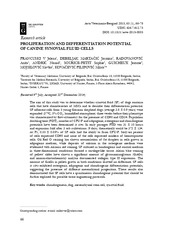Приказ основних података о документу
Proliferation and differentiation potential of canine synovial fluid cells
| dc.creator | Francuski, Jelena | |
| dc.creator | Debeljak-Martačić, Jasmina | |
| dc.creator | Radovanović, Anita | |
| dc.creator | Andrić, Nenad | |
| dc.creator | Sourice-Petit, Sophie | |
| dc.creator | Guicheux, Jerome | |
| dc.creator | Mojsilović, Slavko | |
| dc.creator | Kovačević-Filipović, Milica | |
| dc.date.accessioned | 2020-06-03T13:53:19Z | |
| dc.date.available | 2020-06-03T13:53:19Z | |
| dc.date.issued | 2015 | |
| dc.identifier.issn | 0567-8315 | |
| dc.identifier.uri | https://vet-erinar.vet.bg.ac.rs/handle/123456789/1171 | |
| dc.description.abstract | The aim of this study was to determine whether synovial fluid (SF) of dogs contains cells that have characteristics of MSCs and to describe their differentiation potential. SF adherent cells from 5 young German shepherd dogs (average 3.8 +/- 0.9 years) were expanded (37 degrees C, 5% CO2, humidified atmosphere) three weeks before their phenotype was characterized by flow-cytometry for the presence of CD90 and CD34. Population doubling time (PDT), number of CFU-F and adipogenic, osteogenic and chondrogenic potentials have been determined in vitro. In early passages PTD was 31 +/- 10 hours and expansion fold after 3 sub cultivations (9 days) theoretically could be 372 +/- 134. At P1, 0.55 +/- 0.05% of SF cells had the ability to form CFU-F. Sixty-six percent of cells expressed CD90 and none of the cells expressed markers of hematopoietic cells. Oil Red O staining has shown accumulation of fat droplets in cells grown in adipogenic medium, while deposits of calcium in the osteogenic medium were evidenced with Alizarin red staining. SF cultured in hondrogenic and control medium in three-dimensional conditions formed a cartilage-like tissue. Alcian blue staining of pellets slides have shown a significant amount of glycosaminoglycans (GAGs) and immunohistochemistry analysis documented collagen type II expression. The amount of GAGs in pellets grown in both conditions showed no difference. SF cells in vitro exhibited osteogenic, adipogenic and chondrogenic differentiation potentials, suggesting the presence of different mesenchymal progenitors. These results also demonstrated that SF cells have a spontaneous chondrogenic potential that should be further explored for possible tissue engineering protocols. | en |
| dc.publisher | Univerzitet u Beogradu - Fakultet veterinarske medicine, Beograd | |
| dc.relation | info:eu-repo/grantAgreement/MESTD/Basic Research (BR or ON)/175061/RS// | |
| dc.relation | Bilateral Serbian-French Co-operation "Pavle Savic" | |
| dc.relation | Short Term Scientific Mission COST Action MP1005 - NAMABIO | |
| dc.relation | ANR Tecsan "Chondrograft"French National Research Agency (ANR) | |
| dc.rights | openAccess | |
| dc.source | Acta Veterinaria-Beograd | |
| dc.subject | chondrogenesis | en |
| dc.subject | dog | en |
| dc.subject | mesenchymal stem cell | en |
| dc.subject | synovial fluid | en |
| dc.title | Proliferation and differentiation potential of canine synovial fluid cells | en |
| dc.type | article | |
| dc.rights.license | ARR | |
| dcterms.abstract | Гуицхеуx, Јероме; Радовановић, Aнита; Ковачевић-Филиповић, Милица; Aндрић, Ненад; Француски, Јелена; Мојсиловић, Славко; Дебељак-Мартачић, Јасмина; Соурице-Петит, Сопхие; | |
| dc.citation.volume | 65 | |
| dc.citation.issue | 1 | |
| dc.citation.spage | 66 | |
| dc.citation.epage | 78 | |
| dc.citation.other | 65(1): 66-78 | |
| dc.citation.rank | M22 | |
| dc.identifier.wos | 000351737400005 | |
| dc.identifier.doi | 10.1515/acve-2015-0005 | |
| dc.identifier.scopus | 2-s2.0-84927614465 | |
| dc.identifier.fulltext | https://vet-erinar.vet.bg.ac.rs/bitstream/id/154/1170.pdf | |
| dc.type.version | publishedVersion |

